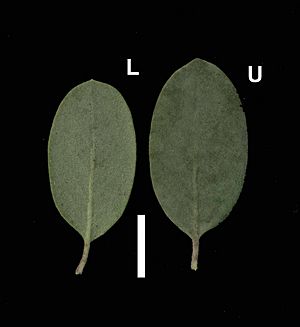Bonny Doon manzanita facts for kids
Quick facts for kids Arctostaphylos silvicolaBonny Doon manzanita |
|
|---|---|
 |
|
| Scientific classification | |
| Kingdom: | |
| (unranked): | |
| (unranked): | |
| (unranked): | |
| Order: | |
| Family: | |
| Genus: | |
| Species: |
A. silvicola
|
| Binomial name | |
| Arctostaphylos silvicola Jeps. & Wiesl.
|
|
The Bonny Doon manzanita (scientific name: Arctostaphylos silvicola) is a special type of manzanita plant. People also call it the silverleaf manzanita. This plant grows only in a small area. It lives in the sandy hills of the southern Santa Cruz Mountains in California. You can find it in Santa Cruz and Santa Clara counties.
Contents
What Does the Bonny Doon Manzanita Look Like?
This plant is a very large shrub. It can grow at least one meter (about 3 feet) tall. Some Bonny Doon manzanitas can even reach over six meters (about 20 feet) high! They can look a lot like small trees.
Its bark is dark red and feels smooth. The leaves are a greenish-gray color. Sometimes, they might feel a little bit fuzzy or "woolly." Each leaf is shaped like an oval and can be up to 3.5 centimeters (about 1.4 inches) long.
Flowers and Fruits
The Bonny Doon manzanita has pretty flowers. They grow in groups called inflorescences. These flowers are shaped like small urns, which are like tiny pots. After the flowers, the plant grows small fruits. These fruits are called drupes. They are usually between 6 and 12 millimeters (about 0.2 to 0.5 inches) wide.
Where Does Bonny Doon Manzanita Live?
The Bonny Doon manzanita grows in specific places. It likes to live in coniferous forests. These are forests with trees like pines and firs. It also grows in chaparral areas. Chaparral is a type of shrubland common in California. This plant prefers to grow in sandy soil that comes from old ocean beds.
Why is Bonny Doon Manzanita Important?
The Bonny Doon manzanita is considered "fairly endangered." This means it needs help to survive. The California Native Plant Society keeps track of its status.
Threats to the Plant
The biggest dangers to this plant are changes to its home. People sometimes dig up sand for building, which is called sand mining. New buildings and roads also take away the plant's natural habitat.
Protecting the Plant
Luckily, some of the areas where this plant grows are protected. For example, a part of its home is safe inside the Bonny Doon Ecological Reserve. This reserve helps keep the Bonny Doon manzanita safe for the future.

